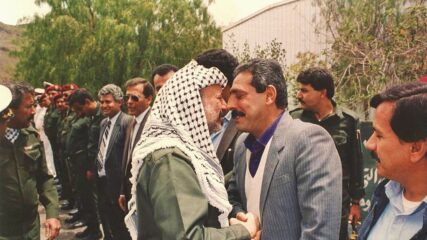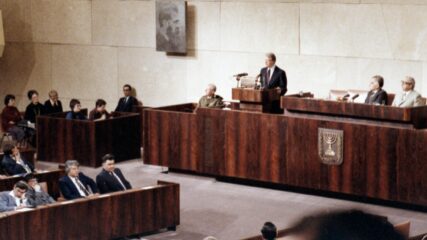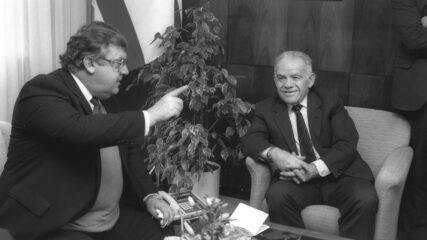April 14, 2025
The period of the New Yishuv lasted from the last 40 years of Ottoman rule in Palestine through the British Mandate until the establishment of Israel in 1948. It saw the growth of the Jewish community from 24,000 in 1882 to some 650,000 in May 1948, while the Arab population increased from 300,000 to approximately 800,000.
In these seven decades, Zionism, the quest to re-establish a Jewish national territory, succeeded in generating the political reality of Israel. Zionist political, organizational, financial, societal and self-defense institutions evolved and grew into the structural framework of what became Israel. Collectively, these institutions formed the foundation for a Jewish national home, promoting self-sufficiency and unity. Living in multiple diasporas for centuries as minorities before the evolution of modern Zionism forced Jews to rely upon one another and to develop small, autonomous, self-governing structures and experiences that Jewish immigrants to Palestine and elsewhere took with them. Decades if not centuries of Diaspora Jewish communal survival evolved into organizations that served Jewish and Zionist needs as the state evolved, then seamlessly transitioned into the organs of the Israeli state.
The New Yishuv expanded beyond the traditional Jewish communities of the Old Yishuv, which were concentrated in the four holy cities: Jerusalem, Hebron, Safed and Tiberias. Jewish settlers during the New Yishuv established agricultural colonies in the coastal plains, valleys and villages, fostering modern urban and rural communities. Zionist organizations, particularly the World Zionist Organization, established in 1897, played a crucial role in assisting Jewish immigration and settlement. The creation of the WZO’s Palestine Office in 1908 formalized the efforts to facilitate Jewish immigration, institution building and land acquisition.
Among the most important were the Jewish National Fund (founded in 1901), Keren Hayesod (1920) and the Jewish Agency (1921). Respectively, they acquired and ameliorated lands, raised funds to support Jewish immigration and infrastructure development, and became the political center recognized and consulted by the British administration that governed the area. Additionally, the Haganah, a Jewish defense organization, provided security to Jewish communities, especially as tensions with the Arab population increased.
British Mandate and Balfour Declaration
The period of British control over Palestine, which began after World War I and was formalized under the League of Nations Mandate in 1922, was marked by the concept of a “dual obligation” of facilitating the establishment of a Jewish National Home while protecting the civil and religious rights of all inhabitants of Palestine, as promised in the letter signed by Foreign Secretary Arthur Balfour in 1917. However, the commitments to the Jewish and non-Jewish communities were not equal. The Zionists were promised an opportunity to evolve a dynamic political presence, stated as a “homeland,” while the Arabs were offered defense of their civil and religious rights.
The British administration sought to implement policies to balance these dual commitments or interests. The mandate government was tasked with promoting Jewish immigration and facilitating close Jewish settlement on the land. Article 4 of the mandate recognized the Jewish Agency as a public body to cooperate with the administration, specifically in economic and social matters. Articles 6 and 11 further stressed facilitating Jewish immigration and land settlement while safeguarding the rights of other communities. When the British offered the Arab community opportunities to evolve their own autonomous political institutions, as an Arab Agency equivalent to the recognized Jewish Agency, Arab leadership in Palestine rejected the overture, wanting instead the cancellation of the Balfour Declaration’s intent to foster a Jewish National Home in Palestine.
Yishuv Institutional Growth
During the mandate, the Jewish community organized itself through a range of communal institutions that gradually became scaffolding for national institutions. Those, in turn, formed the skeletal outlines of departments and ministries for the future state. The Jewish Agency, expanded in 1929, represented Jewish communal interests in cooperating with the British administration, though the Jewish Agency reflected multiple viewpoints about Zionist philosophies. Thus, while the national home’s goal of establishing a firm geographic or territorial presence was almost uniform, pluralistic views of the nature of Zionism lived in parallel to the commitment to the broader objective. The Histadrut (General Federation of Labor), established in 1920, played a critical role in developing the Jewish workforce and economy, organizing trade unions, and creating cooperative enterprises such as Solel Boneh, a construction company responsible for large infrastructure projects. The political structure of the Jewish community also evolved, with the Va’ad Leumi (National Council) acting as the governing body for internal Jewish affairs. It managed civil and religious matters or at least tried to reconcile differing outlooks.
These institutions fostered a strong sense of Jewish national identity and self-reliance, preparing the Yishuv for statehood. The cooperative agricultural settlements — kibbutzim and moshavim — became central to Jewish rural life, reflecting the socialist ideals that guided much of Zionist thought. The Yishuv’s capacity to build self-governing institutions, its focus on education, its health services and its defense contributed to the Jewish community’s resilience and growth, even in the face of escalating tensions with the Arab population.
British Policy Shifts and Conflicts
Despite initial British support for Jewish immigration, the growing unrest between Jews and Arabs led to several British policy shifts. The 1929 riots, in which 69 Jews were killed in Hebron and elsewhere, and the Arab revolt of 1936-1939, in which large numbers of Arabs rioted against the British administration and Jewish demographic and physical growth, exposed deep-rooted Arab opposition to Jewish immigration, land purchase and state building. As a result, the British government issued the 1939 White Paper, which severely limited Jewish immigration to 75,000 over the next five years and restricted Jewish land purchases. Naturally, the Jewish community vehemently opposed these policies, which directly contradicted the Zionist goal of developing the national home. In the late 1930s, in addition to restrictions imposed on Jewish immigration to Palestine, negative government attitudes toward Jews seeking liberty, asylum or refuge existed in North America and in parts of Europe, where antisemitic persecutions reached levels never witnessed previously.
The Jewish community responded by organizing clandestine immigration operations, known as Aliyah Bet, to bring European Jews to Palestine illegally. Additionally, underground Jewish military organizations such as the Irgun and Lehi (Stern Gang) carried out armed resistance against British rule, escalating tensions, in the hope of ending the British administrative presence and accelerating the establishment of a state out of the Yishuv’s growth. The British government’s inability to reconcile Jewish and Arab demands, combined with growing violence, led to its decision in 1947 to refer Palestine’s political future to the new United Nations.
As World War II ended, the Holocaust and the displacement of European Jewry intensified the calls for a Jewish state. The Yishuv had already established a quasi-state infrastructure, with its own political, economic, and military institutions, which facilitated the transition to statehood. The Jewish Agency, led by figures like David Ben-Gurion, took on the mantle of leadership, negotiating with both the British and international bodies.
In late 1947, the United Nations proposed the partition of Palestine into separate Jewish and Arab states, with Jerusalem under international control. While the Jewish leadership accepted the plan, the Arab states and the Palestinian Arab leadership rejected it. Rejection led to the outbreak of the first Arab-Israeli war, which resulted in Israel’s establishment in May 1948.
Legacy of the Yishuv
The New Yishuv period laid the foundations for the modern State of Israel. The Jewish community’s ability to build viable, strong and self-sustaining institutions under adverse conditions showed the commitment of Jews who came from wide geographic origins to engage and persevere in the commitment to a national revival. As the Yishuv grew its population and territorial base, so did the Jewish community’s political distance from Palestine’s Arab population widen. Arab leaders in Palestine and in surrounding countries refused to accept a Jewish political presence, let alone a majority-Jewish political presence, at the eastern Mediterranean. The British Mandate left a deep legacy of unresolved tensions between Jews and Arabs over land, immigration and national identity. The British administration’s attempt to balance its obligations to both Jews and Arabs in the Middle East failed to reconcile their aspirations.









